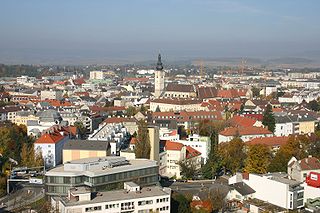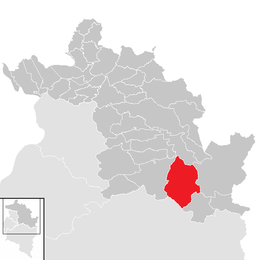
Bregenz (German pronunciation: [ˈbʁeːgɛnt͡s], is the capital of Vorarlberg, the westernmost state of Austria. The city lies on the eastern shores of Lake Constance, the third-largest freshwater lake in Central Europe, between Switzerland in the west and Germany in the northwest.

Sankt Pölten, mostly abbreviated to the official name St. Pölten, is the capital and largest city of the State of Lower Austria in northeast Austria, with 55,538 inhabitants as of 1 January 2020. St. Pölten is a city with its own statute and therefore it is both a municipality and a district in the Mostviertel.

Eisenstadt is a city in Austria, the state capital of Burgenland. It had a recorded population on 1 January 2020 of 14,815.

Neusiedl am See is a town in Burgenland, Austria, and administrative center of the district of Neusiedl am See.

Reuthe is a municipality of the Bregenzerwald,in the westernmost Austrian state of Vorarlberg. It is located in the district of Bregenz. Its main industry is tourism.

Au is a town in the Bregenz Forest in the westernmost Austrian state of Vorarlberg.

Mellau is a town in the Bregenz Forest in the westernmost Austrian state of Vorarlberg, part of the district of Bregenz.

Schwarzenberg is a municipality in the Bregenz Forest in the western Austrian state of Vorarlberg, part of the district of Bregenz. Schwarzenberg has an area of 25.76 km². It lies south of Lake Constance. The village center is heritage-protected for its traditional rustic wooden houses.

Bad Gastein is a spa town in the district of St. Johann im Pongau, in the Austrian state of Salzburg. Picturesquely situated in a high valley of the Hohe Tauern mountain range, it is known for the Gastein Waterfall and a variety of Belle Époque hotel buildings.

Bernstein is a municipality in Burgenland in the district Oberwart in Austria.

Feldkirch is a medieval town in the western Austrian state of Vorarlberg, bordering on Switzerland and Liechtenstein. It is the administrative centre of the Feldkirch district. After Dornbirn, it is the second most populous town in Vorarlberg. The westernmost point in Austria lies in Feldkirch on the river Rhine, at the tripoint between Austria, Switzerland, and Liechtenstein.

Krumbach is a village in the westernmost Austrian state of Vorarlberg, in the Bregenz district. The municipality has about 1,000 inhabitants.

Bruckneudorf is a small town in the district of Neusiedl am See in the federal state of Burgenland in Austria, neighbouring Bruck an der Leitha. Its name means bridge new village, whereas the Hungarian version means royal bridge, and the royal refers to King Francis I. Historically and geographically, Bruckneudorf represents the extension of the Austrian town of Bruck an der Leitha over the Austrian border into Hungary. This border, symbolised by the river Leitha, separated the Austrian Empire from the Kingdom of Hungary. Its main current national significance derives from the Bruckneudorf military exercise ground of the Austrian federal army. Currently it is also the site of Bruck an der Leitha railway station, an important railway station near the borders with Hungary and Slovakia, a stop for nearly all the international trains that pass through it.

Hohenau an der March is a town in the district of Gänserndorf in the Austrian state of Lower Austria, close to Vienna and the borders with the Czech Republic and Slovakia.

Poysdorf is a town in the district of Mistelbach in the Austrian state of Lower Austria.

Vandans is a town located in the Bludenz district in the Austrian state of Vorarlberg. Located 650 m (2133 ft) above sea level, it is known for its skiing and hiking activities.

Bürs is a municipality in the district of Bludenz in the Austrian state of Vorarlberg.

Klösterle is a municipality in the district of Bludenz in the Austrian state of Vorarlberg.

Lingenau is a municipality in the district of Bregenz, in the westernmost Austrian state of Vorarlberg.

Schröcken is a municipality in the district of Bregenz, in the westernmost Austrian state of Vorarlberg.
























